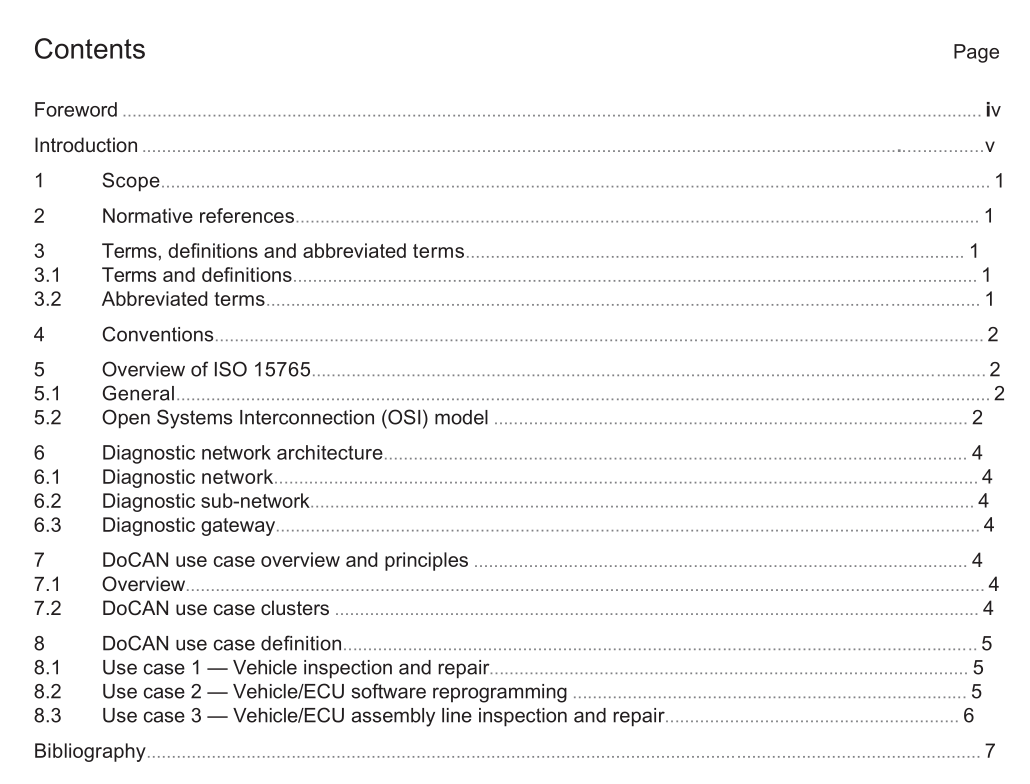BS ISO 15765-1 pdf download

BS ISO 15765-1 pdf download Road vehicles — Diagnostic communication over Controller Area Network (DoCAN) Part 1: General information and use case definition
4 Conventions
ISO 15765 is based on the conventions discussed in the OSl Service Conventions (ISOIEC 10731) as theyapply for diagnostic services.
5 Overview of lSO 15765
5.1General
ISO 15765 is applicable to vehicle diagnostic systems implemented on a CAN communication network asspecified in lso 11898.
ISO 15765 has been established in order to define common requirements for vehicle diagnostic systemsimplemented on a CAN communication link as specified in lSO 11898.
Although primarily intended for diagnostic systems, ISO 15765 has been developed to also meet requirementsfrom other CAN-based systems needing a network layer protocol.
5.2Open Systems lnterconnection (osl) model
ISO 15765 is based on the Open Systems Interconnection (OSI) Basic Reference Model as specified inISO/IEC 7498-1 which structures communication systems into seven layers.
All parts of lS0 15765 are guided by the OSl service conventions as specified in ISO/IEC 10731 to the extentthat they are applicable to diagnostic services. These conventions define the interaction between the serviceuser and the service provider through service primitives.
The aim of this subclause is to give an overview of the OSl model and show how it has been used as a guidelinefor this part of lSO 15765. It also shows how the OSl service conventions have been applied to lSO 15765.The OsI model structures data communication into seven layers called, from top down, application layer(layer 7), presentation layer (layer 6), session layer (layer 5), transport protocol layer (layer 4), network layer(layer 3), data link layer (layer 2) and physical layer (layer 1).
A subset of these layers is used in ISO 15765,which specifies the application, session, transport protocol.network,data link and physical layers for DoCAN.
The purpose of each layer is to provide services to the layer above.The application layer provides services to thediagnostic application. The active parts of each layer, implemented in software, hardware or any combinationof software and hardware, are called entities. In the Osl model, communication takes place between entitiesof the same layer in different nodes. Such communicating entities of the same layer are called peer entities.The services provided by one layer are available at the Service Access Point(SAP) of that layer. The layerabove can use them by exchanging data parameters.
ISO 15765 distinguishes between the services provided by a layer to the layer above it and the protocol usedby the layer to send a message between the peer entities of that layer. The reason for this distinction is to makethe services, especially the application layer services and the transport layer services, reusable for CAN andfor other network types. In this way, the protocol is hidden from the service user and it is possible to changethe protocol if special system requirements demand it.
Figure 1 illustrates the most applicable application implementations utilizing the DoCAN protocol.
6 Diagnostic network architecture6.1Diagnostic network
The diagnostic network, as a whole, contains all the clients and servers that can communicate with each other.A diagnostic network can range from a simple point-to-point connection between a client and a server toa complex distributed network architecture with several physical sub-networks interconnected by diagnosticgateways.
6.2 Diagnostic sub-network
All clients and servers of a sub-network are connected to the same physical communication link.
ln the scope of lSO 15765, all clients and servers of a sub-network are connected to the same physical CANnetwork and are able to communicate directly with each other.
6.3 Diagnostic gateway
A diagnostic gateway is a node in the network that is physically connected to two (or more) sub-networks andhas the ability to transfer diagnostic messages between the sub-networks.
Connecting individual sub-networks via diagnostic gateways creates larger diagnostic network architectures.
7 DoCAN use case overview and principles
7.1Overview
The individual use cases covered by the DoCAN protocol derive from the use of diagnostic communication inthe following areas:
-vehicle/EcU engineering (development);
-vehicle/ECU manufacturing (production plant, assembly line);-service (dealership, aftermarket repair shop);
-legislated inspections (emission-check,safety inspection).
NOTE ISO 15765 will only focus on communication protocol provisions which are necessary to support these usecases. It will not specify data contents, signal update rate, signal availability, etc.









